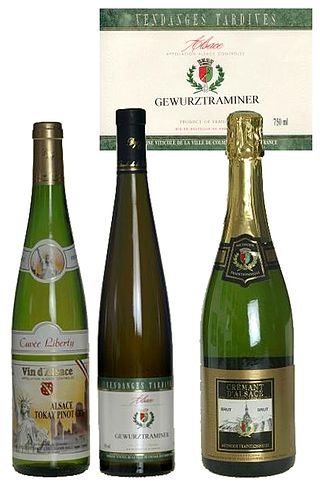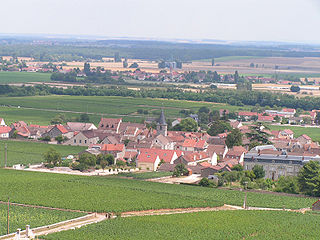
Beaujolais is a French Appellation d'Origine Contrôlée (AOC) wine generally made of the Gamay grape, which has a thin skin and is low in tannins. Like most AOC wines they are not labeled varietally. Whites from the region, which make up only 1% of its production, are made mostly with Chardonnay grapes though Aligoté is also permitted until 2024. Beaujolais tends to be a very light-bodied red wine, with relatively high amounts of acidity. In some vintages, Beaujolais produces more wine than the Burgundy wine regions of Chablis, Côte d'Or, Côte Chalonnaise and Mâconnais put together.

Chablis is the northernmost Appellation d'origine contrôlée of the Burgundy region in France. Its cool climate produces wines with more acidity and less fruitiness than Chardonnay vines grown in warmer ones. These often have a "flinty" note, sometimes described as "goût de pierre à fusil", and sometimes as "steely". The Chablis AOC is required to use Chardonnay grapes solely.

Burgundy wine is made in the Burgundy region of eastern France, in the valleys and slopes west of the Saône, a tributary of the Rhône. The most famous wines produced here, and those commonly referred to as "Burgundies", are dry red wines made from pinot noir grapes and white wines made from chardonnay grapes.

Alsace Grand Cru is an Appellation d'Origine Contrôlée for wines made in specific parcels of the Alsace wine region of France. The Grand Cru AOC was recognized in 1975 by the INAO with subsequent expansion in 1983, 1992 and 2007.

Corton is an Appellation d'origine contrôlée (AOC) and Grand Cru vineyard for red and white wine in the Côte de Beaune subregion of Burgundy. It is located on a hill shared between the three villages of Aloxe-Corton, Pernand-Vergelesses and Ladoix in the Côte de Beaune, Burgundy. The appellation covers the lower parts of the Corton hill and includes several subordinate vineyard names, or climats, within the AOC. Because of the size of the AOC and the variability of these climats, it is the rule rather than the exception that the name of the climat is indicated together with that of the Corton AOC, leading to designations such as Corton Clos du Roi and Corton Les Bressandes. Corton is rare in this aspect, as the 'climat' is seldom used for other Grand Cru appellations in Côte d'Or. The AOC was created in 1937.

Corton-Charlemagne is an Appellation d'origine contrôlée (AOC) and Grand Cru vineyard for white wine in the Côte de Beaune subregion of Burgundy. It is located in the communes of Aloxe-Corton, Pernand-Vergelesses and Ladoix-Serrigny with Chardonnay, and Pinot Blanc being the only permitted grape varieties. Around 300,000 bottles of white wine are produced each year in the appellation.

Romanée-Saint-Vivant is an Appellation d'origine contrôlée (AOC) and Grand Cru vineyard for red wine in the Côte de Nuits subregion of Burgundy, with Pinot noir as the main grape variety. It is situated within the commune of Vosne-Romanée. La Romanée borders on La Grande Rue in the south, Romanée-Conti and Richebourg in the west, Vosne-Romanée Premier Cru vineyards in the north and in the east and also the village Vosne-Romanée itself in the east. The AOC was created in 1936. It takes its name from the Abbey of Saint Vivant, which in Medieval times owned several vineyards among the Vosne-Romanée Grands Crus.
Chapelle-Chambertin is an Appellation d'origine contrôlée (AOC) and Grand Cru vineyard for red wine in the Côte de Nuits subregion of Burgundy, with Pinot noir as the main grape variety. It is located in the southern part of the commune of Gevrey-Chambertin and on the lower hillside east of Chambertin-Clos de Bèze and north of Griotte-Chambertin. The AOC was created in 1937.

Provence (Provençal) wine comes from the French wine-producing region of Provence in southeast France. The Romans called the area provincia nostra, giving the region its name. Just south of the Alps, it was the first Roman province outside Italy.

Cru is a wine term used to indicate a high-quality vineyard or group of vineyards. It is a French word which was originally used to refer to both a region and anything grown in it, but is now mostly used to refer to both a vineyard and its wines. The term is often used within classifications of French wine. By implication, a wine that displays the name of its cru on its wine label is supposed to exhibit the typical characteristics of this vineyard or group of vineyards. The terms premier cru and grand cru designate levels of presumed quality that are variously defined in different wine regions.

Volnay wine is produced in the commune of Volnay in Côte de Beaune of Burgundy, and in some vineyards in the commune of Meursault. The Appellation d'origine contrôlée (AOC) Volnay is only used for red wine with pinot noir as the main grape variety. There are no Grand Cru vineyards within Volnay, but several highly regarded Premier Cru vineyards. The AOC was created in 1937.

Santenay wine is produced in the communes of Santenay and Remigny in Côte de Beaune of Burgundy. The Appellation d'origine contrôlée (AOC) Santenay may be used for red and white wine with respectively Pinot noir and Chardonnay as the main grape variety. The production consists of almost 85% red wine, and a little over 15% of white wine. There are no Grand Cru vineyards within the Santenay AOC.

The wine region of Alsace produces wines under three different Appellations d'Origine Contrôlées (AOCs): Alsace AOC for white, rosé and red wines, Alsace Grand Cru AOC for white wines from certain classified vineyards and Crémant d'Alsace AOC for sparkling wines. This region is the only French wine region allowed to label its wines based on variety.

Vosne-Romanée wine is produced in the commune of Vosne-Romanée in Côte de Nuits of Burgundy as well as in the neighbouring commune of Flagey-Échezeaux. The Appellation d'origine contrôlée (AOC) Vosne-Romanée may only be used for red wine with Pinot noir as the main grape. There are a total of 15 Premier Cru vineyards in the two communes, as well as six Grand Cru vineyards in Vosne-Romanée and two in Flagey-Échezeaux. These Grand Cru vineyards include Burgundy's most iconic, sought-after and expensive red wines, with Romanée-Conti of Domaine de la Romanée-Conti at the pinnacle: "There can be little doubt that in the firmament of the Cote de nuits, Vosne-Romanée is the brightest star."

Meursault wine is produced in the commune of Meursault in Côte de Beaune of Burgundy. The Appellation d'origine contrôlée (AOC) Meursault may be used for white wine and red with respectively Chardonnay and Pinot noir as the main grape varieties. The production of white Meursault dominates, with around 98 per cent. There are no Grand Cru vineyards within Meursault, but several highly regarded Premier Cru vineyards.

Pommard wine is produced in the commune of Pommard in Côte de Beaune of Burgundy. The Appellation d'origine contrôlée (AOC) Pommard is only used for red wine with Pinot noir as the main grape variety. There are no Grand Cru vineyards within Pommard, but several highly regarded Premier Cru vineyards. The AOC was created in 1937.

Auxey-Duresses wine is produced in the commune of Auxey-Duresses in Côte de Beaune of Burgundy. The Appellation d'origine contrôlée (AOC) Auxey-Duresses may be used for red and white wine with respectively Pinot noir and Chardonnay as the main grape variety. The production consists of around two-thirds red wine, and one-third white wine. There are no Grand Cru vineyards within Auxey-Duresses. The AOC Auxey-Duresses was created in 1970. Before the introduction of the appellation system in the 1930s, wines from this village were probably sold under the names of the more famous neighbors Volnay and Meursault. Later, the wines have been sold as Côte de Beaune-Villages, but it has progressively become more common to actually use the Auxey-Duresses AOC for the wines.

Savigny-lès-Beaune wine is produced in the commune of Savigny-lès-Beaune in Côte de Beaune of Burgundy. The Appellation d'origine contrôlée (AOC) Savigny-lès-Beaune may be used for red and white wine with respectively Pinot noir and Chardonnay as the main grape variety. The name of the appellation is sometimes written simply as Savigny, without the -lès-Beaune suffix. The production consists of slightly over 85 per cent red wine, and slightly less than 15 per cent white wine. There are no Grand Cru vineyards within Savigny-lès-Beaune.

Gevrey-Chambertin wine is produced in the communes of Gevrey-Chambertin and Brochon in the Côte de Nuits subregion of Burgundy. The Appellation d'origine contrôlée (AOC) Gevrey-Chambertin may be used only for red wine with Pinot noir as the main grape variety. There are nine Grand Cru vineyards within the commune of Gevrey-Chambertin, Chambertin and eight others called Chambertin in combination with something else, such as Chapelle-Chambertin. While Gevrey-Chambertin also has several highly regarded Premier Cru vineyards, it has a particularly large amount of vineyards at the village level for a Côte de Nuits appellation. This is because the vineyards of the AOC stretch further to the east than in most neighbouring AOCs.


















